As they say, “What can be measured, can be managed”. Performance measurement is the second most important activity after Planning (of course). While accurate and realistic planning is the backbone of a successful project, an accurate and diligent performance measurement may be called its eyes and ears. Even if you know the path, without eyes and ears It may not be possible for anyone to reach the intended destination. In this guide, we will explore the Planning and Performance Measurement Using Man-hours-based Technique.
To make a project successful, every activity and every aspect of the project must be measured and monitored diligently.
There are various methods adopted for the purpose of performance monitoring. Some of those methods are as follows:
Revenue-based monitoring
This is a simple method in which project performance is evaluated by plotting actual revenue figures with the planned revenue figures.
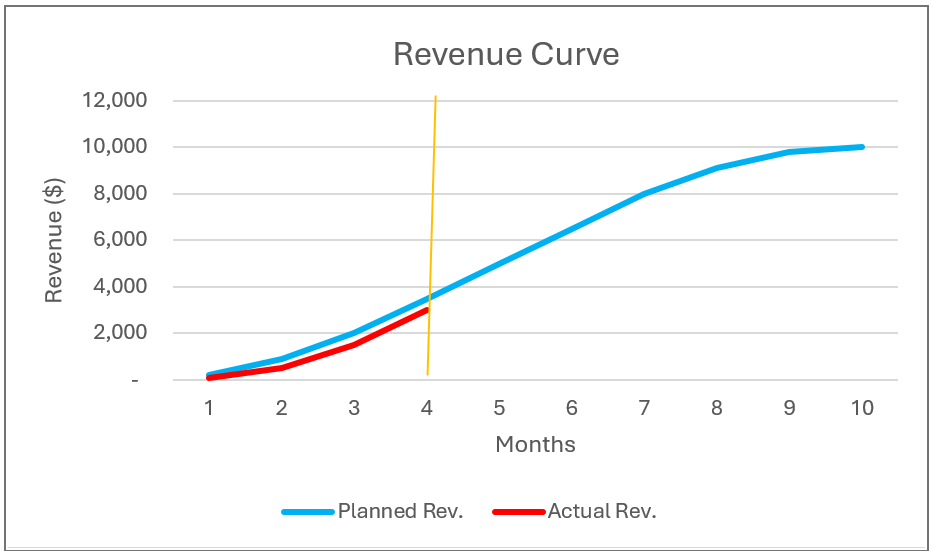
Cost-based monitoring (Earned Value Management)
Earned Value Management is a modern-day technique to measure project performance while integrating schedule, cost, and scope. By using this technique, we can assess if the current cost and progress performance are positive or negative. EVM technique can also be used to forecast Cost at Completion (CAC) and Cost To Complete CTC) for the project.
EVM develops and monitors three key dimensions i.e.
a) Planned Value (PV) or Budgeted Cost of Work Scheduled (BCWS)
PV or BCWS is taken from the approved Cost Baseline of the Project. It is the budget assigned to the planned work.
b) Earned Value (EV) or Budgeted Cost of Work Performed (BCWP)
It is the budget assigned to the work completed.
c) Actual Costs (AC) or Actual Cost of Work Performed (ACWP)
It is the cost incurred in executing the work in this period.
Below is a sample chart used for Earned Value Management (EVM). This chart shows the Planned value (PV or BCWS), Earned Value (EV or BCWP), and Actual Cost (AC or ACWP) at a certain point in time (Data Date).
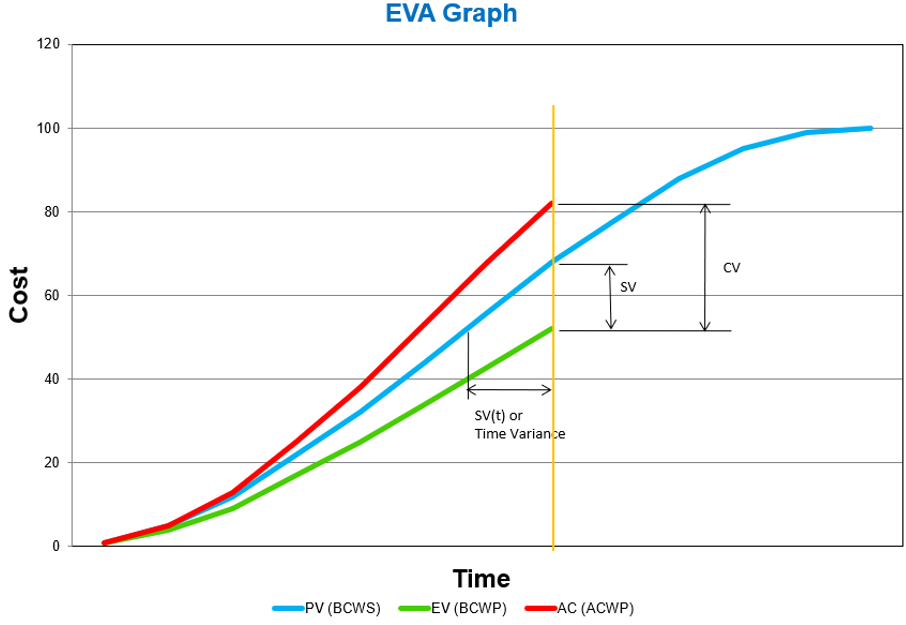
i) Cost Variance (CV)
It is the difference between budget allocation against the amount of work done and the actual cost incurred in performing that work. This determines the cost performance of a project. It is equal to the earned value (EV or BCWP) minus Actual Cost (AC or ACWP) i.e.
CV = EV – AC or CV = BCWP – ACWP
If CV value is positive, the project is currently within budget (spending less than planned for the executed work) but if CV value is negative, the project is currently exceeding budget (spending more than planned for the executed work)
ii) Schedule Variance (SV)
It is a measure of the schedule performance of a project. It is the difference between the earned value (EV or BCWP) and the planned value (PV or BCWS). i.e.
SV = EV – PV or SV = BCWP – BCWS
If the SV value is positive, the project is currently ahead of schedule, whereas if the SV value is negative, the project is currently behind schedule.
Man-hours based monitoring
Man-hours-based monitoring is generally preferred by most project management companies as it gives detailed and accurate monitoring results which include planned man-hours, earned man-hours, actual man-hours, and labor efficiency. Each of these terms will be explained below:
Let us consider an example in which we have a project with different activities.

If we need to know how much the project has progressed, we can, at the most, calculate progress against each activity by dividing Achieved Quantity by the Total Quantity of that activity and then multiplying by 100 to obtain the %age progress. We cannot do so to calculate Overall Progress %age because of different measuring units for different activities and hence quantities cannot be added. To calculate the Overall Progress %age, we need to convert all these activities into the same measuring unit. These units may be Revenue ($), Cost ($), or the man-hours or the effort. Progress measurement based on Revenue and Cost have been briefly discussed above so here we will discuss progress measurement based on man-hours of the effort. To understand this concept completely we need to understand some basic terminologies like:
- Man-hours: It is a yardstick for the measurement of effort by multiplying no. of persons working by the hours they worked. For example, 4 Man-hour will mean 1 man working for 4 hours or 4 men working for 1 hour.
- Standard Man-hours per unit: Estimated man-hours (effort) required to execute one unit of any activity.
- Earned Man-hours: These are the permissible or budgeted man-hours against the executed activity.
- Actual Man-hours: These are the man-hours actually consumed in executing an activity.
- Project (Budgeted) Man-hours: Total number of man-hours required (Budgeted) to execute a project.
Let us now see how we can convert activities with different units of measure into a single unit of measure i.e. Man-hours:

Standard man-hours are estimated man-hours that are allowed to be spent in order to execute 1 unit of that activity. When we multiply Total Quantity with Std. Mhrs./Unit then we get the Total Man-hours required to execute that activity completely. By using this technique, we can convert all activities into one measuring unit i.e. Man-hours or Effort. Activity-wise Budgeted Man-hours can be added to calculate the Total Budgeted (permissible) Man-hours to complete the project.
Now we can easily calculate %age progress against each activity by dividing the Earned Man-hours of the activity by the Budgeted Man-hours of that activity and multiplying by 100. Similarly, Overall %age progress can be calculated by dividing the Total Earned Man-hours by the Total Budgeted Man-hours and multiplying by 100 along with the project overall. This way we can also calculate activity-wise and overall project efficiencies as follows:

| Total | X | X | X | 2,200 | X | 630 | 28.6% | 620 | 1.02 |
To enhance your project management strategies, consider diving into CPM scheduling. This technique can streamline your planning process and ensure more efficient use of your team’s time.
Man-hours based Scheduling
Based on the same concept we can make a man-hours-based schedule. The advantage of a man-hours-based schedule is that we can calculate manpower requirements to execute the scheduled activities as follows:

Various IT-based software are available to help us in Man-hours based scheduling and monitoring. Two commonly used software are Oracle Primavera P6 and Microsoft Project.
In Oracle Primavera P6 scheduling software we assign all required resources including manpower, materials, and construction equipment to each activity as follows:
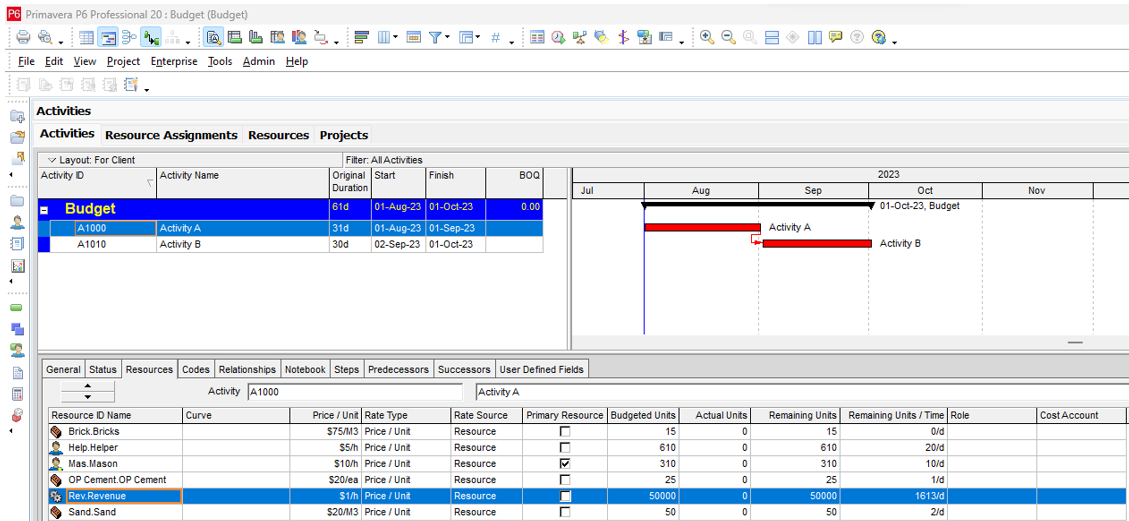
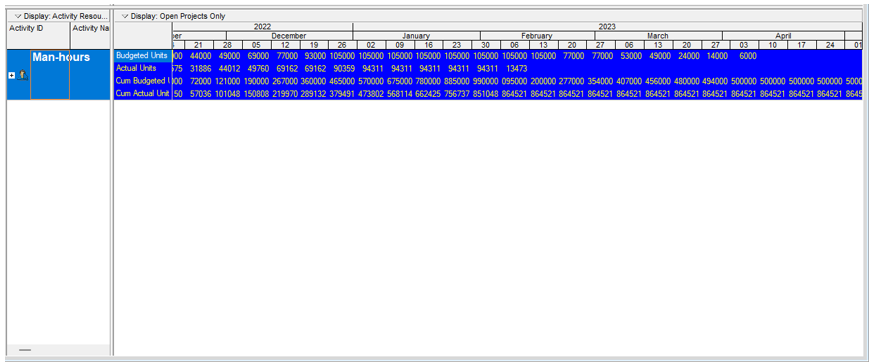
We can also generate cumulative man-hours requirement which is also known as an S-curve (named because of its resemblance with alphabet “S”).
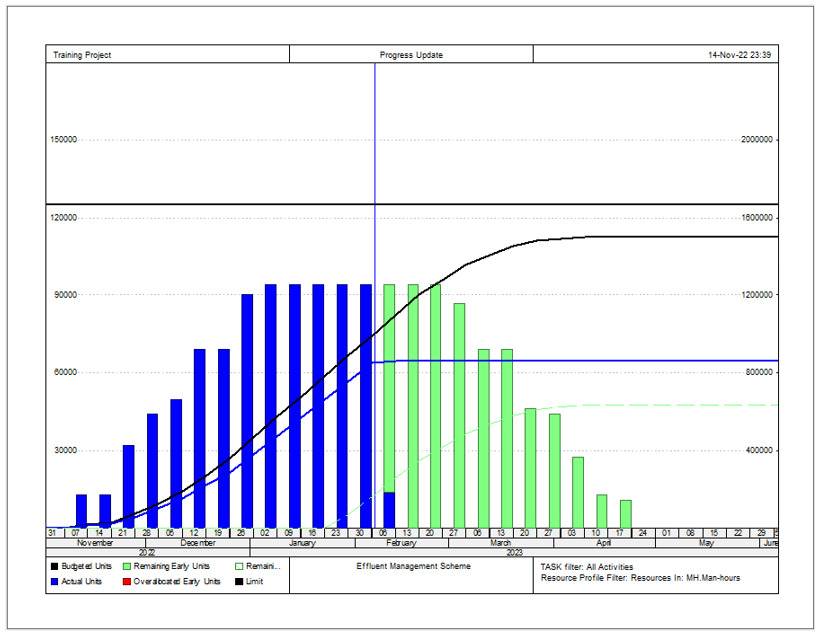
Periodic updating in Oracle Primavera P6 scheduling software gives you man-hours-based actual progress.
Conclusion:
There can be many techniques for scheduling and monitoring of construction projects for example revenue based, cost based, and Man-hours-based. The most commonly used technique is man-hours-based scheduling and monitoring.
Contact us today for your next Construction Scheduling Project. Scheduling and monitoring is a very commonly used technique worldwide by renowned project management organizations. This technique not only provides accurate schedule and monitoring results but also manpower requirements and execution efficiency.





